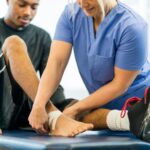
Plantar Fasciitis: Heal Pain – Get Back on Your Feet!
Back on Your Feet: Effective Physical Therapy for Plantar Fasciitis
Are you tired of waking up with a stabbing pain in your heel? Does the thought of standing or walking fill you with dread? If so, you might be suffering from plantar fasciitis. This common yet painful condition can significantly impact your daily life, but the good news is, it’s treatable. At Physical Therapy and Sports Rehab, we specialize in providing tailored treatments that can help you say goodbye to heel pain for good.
Common Causes and Symptoms of Plantar Fasciitis
Plantar fasciitis occurs when the plantar fascia, a thick band of tissue that runs across the bottom of your foot and connects your heel bone to your toes, becomes inflamed. This inflammation is typically caused by repetitive strain or overuse.
Common Causes:
- Overuse from high-impact activities such as running or jumping
- Prolonged standing on hard surfaces
- Poor footwear with inadequate support
- Obesity, which adds extra stress on the feet
- Age-related changes in the foot
Symptoms to Look Out For:
- Sharp, stabbing pain in the heel or bottom of the foot, especially upon waking up or after periods of inactivity
- Increased pain after exercise (not during)
- Swelling in the heel
How Physical Therapy at PT&SR Can Help Treat Plantar Fasciitis
Physical therapy is a highly effective treatment for plantar fasciitis. At Physical Therapy and Sports Rehab, we offer a comprehensive treatment plan tailored to your specific needs. Our techniques include:
Manual Therapy:
Hands-on techniques to massage and stretch the plantar fascia and surrounding muscles, which helps to reduce tension and improve mobility.
Therapeutic Exercises:
Customized exercise programs designed to strengthen the muscles in your foot and lower leg, which can provide better support to your plantar fascia.
Ultrasound Therapy:
Utilizing sound waves to stimulate blood flow and promote healing in the affected area.
Orthotics:
Specially designed shoe inserts that provide better arch support and reduce pressure on the plantar fascia.
Prognosis and Time to Recovery
With prompt and effective treatment, most patients experience significant improvement in their symptoms within a few weeks. Consistent physical therapy can lead to a full recovery in about 6 to 8 weeks, allowing you to return to your normal activities pain-free.
Take Action!
Don’t let plantar fasciitis keep you from enjoying your daily activities. At Physical Therapy and Sports Rehab, our experienced therapists are ready to help you achieve a pain-free life. Schedule an evaluation today to start your journey towards recovery. Contact us at 781-686-8667 or make an appointment.
By addressing your plantar fasciitis with professional care, you can take the first step towards a healthier, more active lifestyle. Don’t wait – let us help you get back on your feet!
We are here for you.
Our team of experienced Physical Therapists is ready to provide you with personalized care and effective treatment solutions. For more information or to schedule your first step towards relief and improved health, contact us at (781) 769-2040 or request an appointment online.















